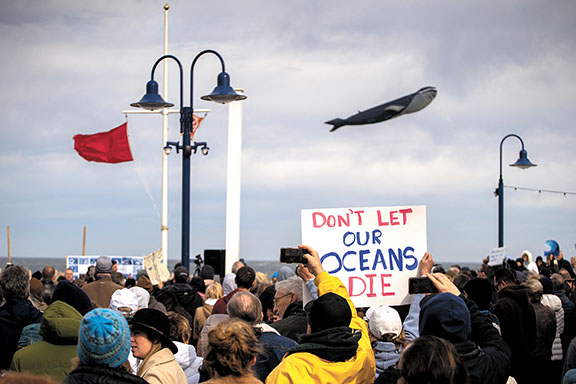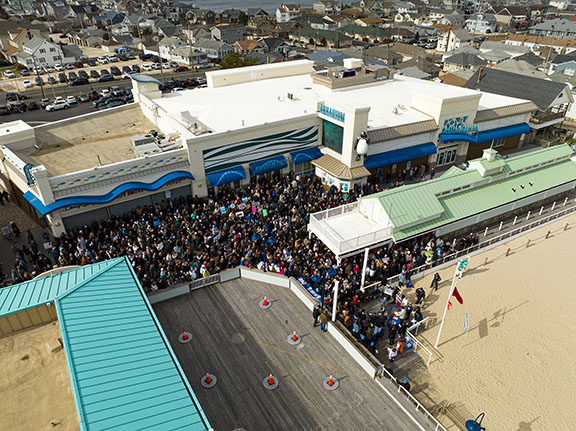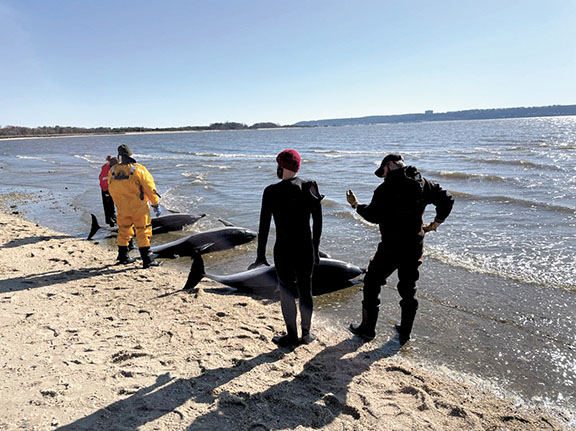
By Sunayana Prabhu
SANDY HOOK – Three dolphins died in the shallow waters of the bay off Gateway National Recreational Area Feb. 18, as citizens and activists continue to grapple with the recent surge in whale deaths along the New Jersey and New York coastline.
The cause of death of the three common dolphins is still under investigation as authorities from the Marine Mammal Stranding Center (MMSC), the only federally-authorized marine hospital in the state of New Jersey, were on the scene and removed the dolphins to perform necropsies.
Within a few weeks in February, in addition to the three dolphins at Sandy Hook, the MMSC reported two additional whale deaths on the region’s coastline: a humpback whale in Manasquan and a minke whale in Rockaway Beach, New York. That follows the deaths of seven other whales from South Jersey to New York in the last two months.
While the cause of the grim flurry of recent deaths is still unknown, Cindy Zipf, executive director of Long Branch-based Clean Ocean Action, an environmental nonprofit, believes they are a result of “the significant amount of offshore wind pre-construction activity. There is reason to believe that there may be a connection.”

There are currently nine off shore wind projects in development off the coast of New Jersey, including Orsted Offshore North America’s two projects – Ocean 1 and 2, around 13 miles off the coast of Atlantic City, in development since April 2022 – and the Empire Wind Project awarded by the state of New York Feb. 17, approximately 18 miles from the Gateway National Recreation Area at Sandy Hook.
Six additional companies with projects covering 488,000 marine acres in the waters of the New York Bight, were auctioned for a total amount of $4.37 billion by the Bureau Of Ocean Energy Management (BOEM). The six leased areas in the NY Bight could generate up to 7 gigawatts of offshore wind energy, enough to power nearly 2 million homes.
BOEM is the federal agency for all offshore wind energy projects within federal waters. It facilitates lease sales of Outer Continental Shelf blocks (OCS) or submerged lands in U.S. coastal waters, for the development of offshore wind energy facilities.
Zipf said federal agencies like the National Marine Fisheries Service have issued 11 companies “Incidental Harassment Authorizations, which allow harming a total of 63,820 mammals. Plus, five more offshore wind survey projects are pending which propose to harm an additional 90,000 mammals.”
Clean Ocean Action has launched an online petition to demand an independent investigation of the whale deaths.
The petitioners have called for a “hard stop” on all offshore wind industry preconstruction, in-water development, or construction activities until they are independently cleared of any involvement in marine mammal deaths.
Lamenting the surge in whale deaths, nearly 1,000 concerned citizens, activists and officials protested at a Save the Whales rally held Feb. 19 at Point Pleasant Beach. Many there echoed Zipf’s concerns, blaming ocean floor preparation work being done along the coastline for the development of offshore wind energy farms. They also called for a temporary pause in the wind farm prep to investigate the matter.
“I don’t want to find out 10 years from now that we’ve had fish killed, habitats have been decimated… not just the whales but everything else,” U.S. Rep. Chris Smith (R-4), said at the rally.

Smith introduced legislation Feb. 17 requiring the U.S Government Accountability Office (GAO) investigate the environmental review process for offshore wind projects, including the impacts on whales, finfish, marine mammals, benthic resources, commercial and recreational fishing, air quality and greenhouse gas emissions, vessel traffic, tourism, and the sustainability of shoreline beaches and inlets.
However, federal authorities from MMSC have pushed back, requesting the public wait until their official findings determine the cause of the deaths. No evidence has yet been found that wind energy projects have resulted in whale fatalities.
“To assign blame before the scientific data is analyzed and interpreted would be premature and could dilute our impact on championing changes on behalf of these animals in the future,” officials from the Marine Mammal Stranding Center said in a statement Feb. 17 on the organization’s Facebook page in response to citizens and conservationists, assuring they are “approaching this investigation in a non-biased manner.”
MMSC’s statement further explained that when frontline members respond to any strandings, they perform necropsies and collect any samples that are viable based on the condition of the carcass. “Once we have collected the samples, they are sent to the laboratory pathologists who are responsible for processing and analyzing. When the pathologists have completed their work, the scientists who are tasked with researching the ongoing Unusual Mortality Event (UME) interpret the findings.”
On Tuesday, Zipf doubled down on her concerns. “Where’s the government’s evidence that there is no connection?” she asked. Zipf said companies have been permitted to conduct “noisy, intense” survey activities, including using sonar “which is known to cause harm to mammals” in the course of wind farm preparations.
“It’s very curious, but that’s the system,” she said.
The Unusual Mortality Event (UME) report is published by the National Oceanic and Atmospheric Administration (NOAA) and noted at least 10 humpback whale deaths in 2023; six of those deaths have occurred in the New Jersey-New York region.

Data collected by the agency since Jan. 1, 2016, has found nearly 184 deaths along the Atlantic Coast from Maine through Florida – 26 from New Jersey and 35 from New York.
The Marine Mammal Stranding Center has been involved with UME investigations previously, noting there could be many causes for the whale deaths, from environmental pollutants to vessel strikes, entanglement in fishing gear or other reasons.
The MMSC statement also noted that in the summer of 1987, hundreds of bottlenose dolphins washed ashore in New Jersey and elsewhere along the East Coast. After several months of necropsies and sample collection, the cause was found to be a virus that had spread through the population. A similar viral event occurred in the summer of 2012.
Under President Joseph Biden’s administration, the goal is to create “30 gigawatts of offshore wind in the United States by 2030, while protecting biodiversity and promoting ocean co-use.”
Gov. Murphy signed an executive order in September increasing the offshore wind goal by nearly 50% to 11,000 megawatts by 2040.
The Most Recent Whale Deaths
• On Feb. 13, a large humpback whale was reported dead on the Manasquan Inlet beach by MMSC. Teams from MMSC and the Atlantic Marine Conservation Society who responded gathered information about this whale made plans for a necropsy. According to a press release from the office of the Monmouth County Commissioners, the county’s department of public works assisted the teams in moving the dead whale to a county facility for examination and tissue sampling. The humpback whale was identified as a juvenile female, about 35 feet long.
• On Feb. 17, not very far from the Jersey coastline, a 25-foot adult female minke whale washed ashore on Rockaway Beach, in Queens. According to the Atlantic Marine Conservation Society’s post on Facebook, the animal had several broken bones and cut wounds across its body, all of which were sampled and appear to have occurred prior to death. There was additional evidence of blunt force trauma. The marine conservation team confirmed from preliminary evidence that the whale died from a vessel strike.
The MMSC requests anyone who comes across a marine mammal in distress contact the Greater Atlantic Marine Mammal Stranding Hotline at 866-755-6622.
The article originally appeared in the February 23 – March 1, 2023 print edition of The Two River Times.














